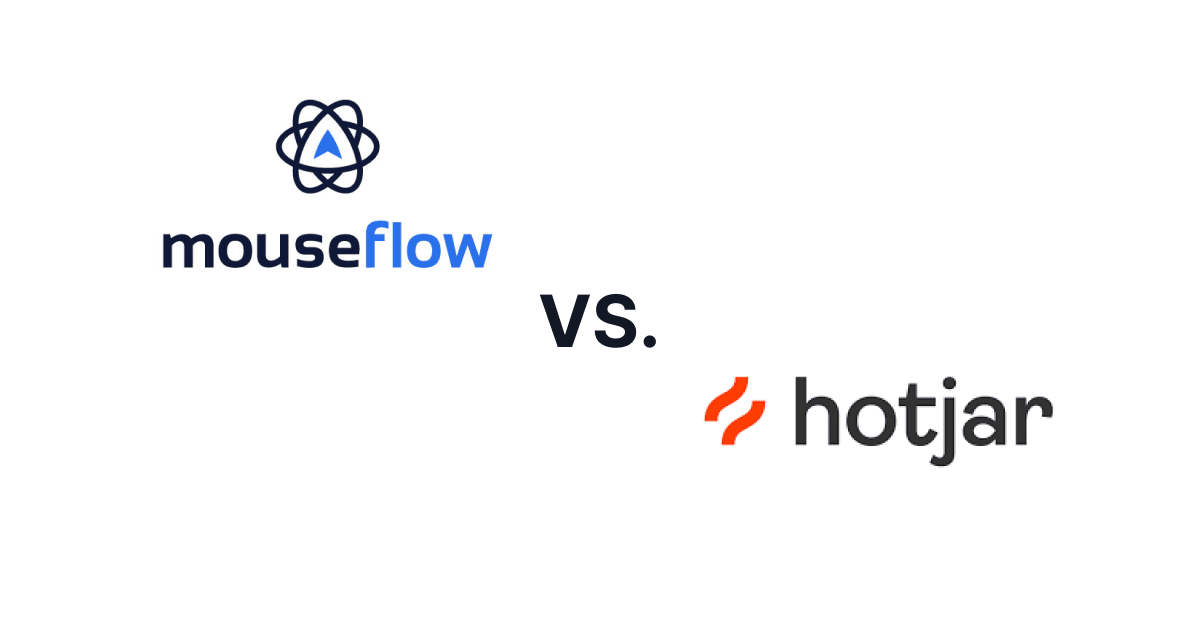In this post, I’ll be comparing Mouseflow vs. Hotjar. Both web analytics software offers exceptional heatmap and user session recording services that can provide in-depth information about how visitors use your website.
They also make a lot of other tools available to help your business track data, improve your site’s usability, and get an overall picture of website performance.
But which one is better? This article compares Mouseflow and Hotjar to help you decide which tool to choose.
Mouseflow vs. Hotjar Overview
Mouseflow:
Mouseflow is a heatmap and website analytics tool that allows you to track user behavior on your website. It tracks mouse movements, clicks, and scroll patterns and gives insights into your users’ actions on your site.
It also includes tools with a session replay feature, customer surveys, and form analytics.
Mouseflow is ideal for tracking eCommerce sites since it lets you see where site visitors are going on your site.
Hotjar:
Hotjar is also an all-in-one analysis tool that allows you to track user behavior on your website, including mouse movement and clicks, scroll patterns, session recordings, and more.
It also has a survey feature that lets you ask questions about specific content or features on your site.
Both Hotjar and Mouseflow are suited for websites that want more information about their visitors than just where they click or scroll – this includes eCommerce sites looking to learn more about their customers. Still, it can also be useful for other types of websites too.
Here’s a detailed breakdown of both tools:
Mouseflow vs. Hotjar: Detailed Overview
1. Heatmaps
A heatmap is a graphical representation of data that uses color to highlight the hottest areas of your website. The higher the temperature, the more activity there is in that region.
It’s a great way to see where users click on a page and what they do (or don’t do). They also let you see how long people stay on a particular part of a page.
Let’s see how Mouseflow and Hotjar compare in terms of heatmaps:
Mouseflow:
Mouseflow’s online heatmap tool lets you record 100% of your traffic from desktop or mobile devices. In addition, Mouseflow allows you to track any page on your website, not just the pages on which you have placed a tracking pixel.
This also means you can retroactively analyze user behavior for 3-12 months without manually setting it up.
Mouseflow offers six website heatmap tools: click, scroll, attention, movement, geo, and live heatmap.
These heatmaps help you determine the following:
- Where your visitors are clicking on the page
- Which parts of the page are getting more attention than others
- How long do users spend on different pages, and how far down do they scroll
- What parts of a page are receiving the most clicks, and which parts are ignored altogether
- What distracts users from the journey
- Where is your user base located
- How users interact with dynamic menus, iframes, and elements
Mouseflow also offers a Friction Score feature that makes it easy to find where your visitors are getting frustrated with your site. This automatic feature can pinpoint the happiest or least satisfied users so you can jump in and examine the heatmaps for the best results.
You can share heatmaps and session recordings with stakeholders to give them a visual sense of your recommendations, making collaboration more productive.
Hotjar:
Hotjar’s heatmap tool is one of its most prominent features. It helps you understand how your users are interacting with your website. The tool displays where visitors click on your website in real time, allowing you to see what is most important to them.
Hotjar offers three types of heatmaps: click, move, and scroll maps.
- Click Heatmap – A click heatmap is a visual representation of where visitors click on a webpage. This type of heatmap is useful for identifying popular areas of your website, as well as the areas that need improvement.
- Move Heatmap – A move heatmap shows where users have moved their mouse while viewing your website. Move heatmaps can identify usability issues with your website and show where people need help navigating.
- Scroll Heatmap – Scroll heatmaps show how far users scroll down on a page before they stop or click on something else. Scrolling is an essential part of any website since it helps visitors find what they’re looking for quickly and easily.
These maps help you determine what elements of your app or website appeal to users and which ones they overlook.
If you make changes to your pages or forms, Hotjar’s heatmap will show you if your changes worked. You won’t make decisions based on guesses when you have reliable data from real users.
Besides, you can study which content fails to load and determine how user behavior changes depending on the device they use – desktop, tablet, or mobile.
Other features of Hotjar’s heatmaps include:
- Unlimited heatmaps
- Heatmaps for all the pages on your site
- Ability to combine multiple pages
- Ability to combine different versions of a page into one heatmap
- Ability to set up heatmaps on every single page using just one script
- Ability to compare user behavior over time
- Unlimited users
Final Verdict: Mouseflow
Both Mouseflow and Hotjar have their individual features and advantages. If you look at Hotjar, it offers unlimited heatmaps for all the pages on your site. The data collected can be used to analyze user behavior and spot pain points.
Mouseflow’s heatmap tool also offers many of the same features as Hotjar, but it stands out with its geo heatmaps, dynamic heatmap functions, and friction score feature. This tool pinpoints the happiest or the unhappiest users so you can analyze data and take impactful actions.
2. Session Replay
Session replay tools capture every action users take on your website or app, then allow you to review them in detail. The data that session replay tools collect can be invaluable for improving conversion rates, customer experience, and more.
Mouseflow:
Mouseflow’s session recording is a one-click process. You don’t have to do anything after clicking ‘record’ – it starts tracking your users as soon as you click.
With Mouseflow, you can watch your users’ sessions – the actual user journeys – and see what works for them. From there, you can focus on what you know is broken and recover conversions while saving time.
And if you want to dig even deeper, you can use tags, variables, filters, cohorts, and layer recordings from custom-defined groups to discover source-specific insights.
Moreover, Mouseflow’s session recordings are private, and it protects privacy in line with the EU’s General Data Protection Regulation (GDPR) and California Consumer Privacy Act (CCPA).
Hotjar:
With Hotjar’s Session Recordings, you can see how customers use your website. So when you feel stuck, watch your customers in action, and you’ll have many ideas for improving everything from load time to checkout flow.
Recordings also work great for checking whether an idea is working as expected. Or you can use them to gather reliable evidence of real user experience and decide what to build next.
In addition, you can use the filter option to find out which users are rage-clicking and u-turning to pinpoint and solve problems quickly.
Final Verdict:
Mouseflow and Hotjar can track a user’s journey through an entire session. However, Hotjar does not provide automatic usability friction detection.
3. On-site Feedback
Customer feedback is an essential part of every business. It can be a powerful tool for improving customer experience, increasing sales, and improving conversion rates.
Both tools allow you to create surveys that you can embed directly into your website. Let’s see how they compare:
Mouseflow:
With a feedback campaign, Mouseflow allows you to listen to your customers, capture feedback when it matters, and give them the online experience they want.
You can catch customers who are about to leave and ask for feedback about what is keeping them from making their buying decision. You can also select your audience, the time of day you send a message, and whether your campaign should be persistent. Improving a product and customer experience go hand in hand.
When creating questions, you can choose from free-text, multiple-choice, and NPS options. You can then use the answers people give to these questions to create helpful content or design touchpoints that engage users.
There’s a feature that will alert you via Slack, email, or other integrations whenever a user submits a new response.
Hotjar:
Hotjar’s Live feedback allows you to see how your users are experiencing your site as they use it. You can hear from them as they use your site and observe their behavior as they navigate different pages and sections.
You can easily spot areas for improvement by comparing the feedback score on every page. You can also see which parts of your site are underperforming.
Moreover, it’s best to use this feature in tandem with session recording. For instance, whenever you receive negative feedback, you can view the recording to see what went wrong and focus on what to work on next. The Feedback feature allows you to identify and correct problems before they develop, resulting in fewer support tickets.
The best part is there is no cap on their paid plans, no storage limit to worry about, and you can look back at feedback over the years. You can also collect feedback in more than 40 languages with a single script. Setting up is also easy—you can set up Feedback across your site with only one script.
The best part? Hotjar’s live feedback lets you add reactions to surveys and make them more interactive, increasing engagement. You can also send feedback using a public link, tag a teammate in the comments or integrate with Slack, making collaboration easy.
Final Verdict:
Mouseflow lets you choose from free text, NPS, and multiple choice when gathering user feedback. However, Hotjar’s new interactive reaction feature seems more innovative and promises to engage users while getting you quick, actionable feedback.
4. Third-party Integrations
The great thing about these tools is that they integrate with each other, which means you can use them together to better understand what your users are doing on your website.
Mouseflow:
Mouseflow’s integration feature makes gathering data from different sources easy so that you can track and optimize your marketing across platforms.
Mouseflow can be integrated with 45 tools, including Abode Analytics, Intercom, Optimizely, Hubspot, Tealium, Google Optimize, Google Analytics, Zendesk, WordPress, Shopify, Wix, and more.
Hotjar:
You can integrate Hotjar with several popular apps to automate your work without writing code, allowing you to focus on what matters most.
It integrates with popular tools, including Slack, Zapier, Google Analytics, Optimizely, Segment, Hubspot, Google Optimize, and Omniconvert.
Final Verdict:
Finally, if you compare the integration options of Hotjar and Mouseflow, Hotjar wins hands down for offering thousands of integrations through Zapier.
Mouseflow Unique Features
Auto-tagged friction events
Have you ever wondered how many people abandon their shopping carts or leave a website without completing a purchase? Friction is any obstacle preventing a user from performing the desired action.
Luckily, Mouseflow’s Friction Scores can help you pinpoint areas where users are frustrated. So rather than scrolling through data, you can spend your time making improvements.
Custom triggers for every feedback scenario
Custom Triggers are special events that fire when specific actions occur on your website (e.g., when someone clicks on an element or scrolls down).
The most common use case for custom triggers is collecting feedback from users by asking them questions through chatbots or popups after they complete specific actions on your site — such as filling out a form or performing an action on a page.
Mouseflow’s custom trigger feature lets you survey users when they experience problems with your site or app, such as click errors, click rage, or inactivity. You can ask for feedback on any page or stage of their journey.
The best part? You can also select your audience and level of persistence.
Hotjar’s Unique Features
Reactions in Surveys
Reactions are a great way to get feedback from your visitors. With Hotjar, you can create surveys and ask your visitors to react to different statements. The more reactions you receive, the better insight you will have into how people feel about specific topics, which ultimately helps you make better decisions for your business.
Reaction in Survey is a new feature of Hotjar that allows you to get quick, actionable feedback—and boost engagement.
The new reaction question feature also lets you add a Reaction question to your surveys – letting your users provide a quick rating with Hotjar buddies, emojis, or stars.
It helps improve your surveys by making them more interactive and allowing users to give you an instant rating. People don’t like typing in text-based responses, but they do like giving star ratings. And once they participate in the initial survey, they are more likely to respond again with their in-depth opinions.
One of the best parts of this feature is that it lets you easily measure sentiment over time.
It doesn’t stop there. By clicking ‘Play’ on a Hotjar survey response, you can watch a recording of the user’s experience before they left feedback. You can combine survey responses with recordings to get a complete picture of what happened during their visit to your site.
Extensive Integration Options
Hotjar has excellent integrations with popular workflow tools like Zapier, making it easy to analyze user behavior and prioritize product improvements. Combining Hotjar insights with other analysis tools can drive results and increase company buy-in.
Not just that, you can now receive insights from Hotjar directly in Slack. Access to user experience data and ongoing conversations in Slack will help you back up your plans for your next moves.
Over to You!
Both Mouseflow and Hotjar are great tools for website owners. If you don’t have the design resources to build your analytics suite or have never used any web analytics tools, Mouseflow and Hotjar are outstanding solutions.
It really comes down to what your primary goal is.
If you’re a marketing team looking to optimize your conversion funnel, Mouseflow is a tool that will reveal your users and their behavior. The tool’s dynamic heatmaps, form analytics, and session replays will help you spot invisible problems in your users’ journey that are stopping them from taking the next step.
Hotjar gives product teams insights into how customers use their products. With actionable data from heatmaps, session replays, and surveys, you can make changes to improve your customer experience. Product designers can see what works and what doesn’t so they can iterate their designs based on customer feedback. Researchers can quickly learn what matters most about your product.



